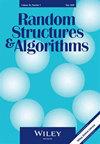Counting partitions of Gn,1/2$$ {G}_{n,1/2} $$ with degree congruence conditions
IF 0.8
3区 数学
Q4 COMPUTER SCIENCE, SOFTWARE ENGINEERING
引用次数: 2
Abstract
For G=Gn,1/2$$ G={G}_{n,1/2} $$ , the Erdős–Renyi random graph, let Xn$$ {X}_n $$ be the random variable representing the number of distinct partitions of V(G)$$ V(G) $$ into sets A1,…,Aq$$ {A}_1,\dots, {A}_q $$ so that the degree of each vertex in G[Ai]$$ G\left[{A}_i\right] $$ is divisible by q$$ q $$ for all i∈[q]$$ i\in \left[q\right] $$ . We prove that if q≥3$$ q\ge 3 $$ is odd then Xn→dPo(1/q!)$$ {X}_n\overset{d}{\to \limits}\mathrm{Po}\left(1/q!\right) $$ , and if q≥4$$ q\ge 4 $$ is even then Xn→dPo(2q/q!)$$ {X}_n\overset{d}{\to \limits}\mathrm{Po}\left({2}^q/q!\right) $$ . More generally, we show that the distribution is still asymptotically Poisson when we require all degrees in G[Ai]$$ G\left[{A}_i\right] $$ to be congruent to xi$$ {x}_i $$ modulo q$$ q $$ for each i∈[q]$$ i\in \left[q\right] $$ , where the residues xi$$ {x}_i $$ may be chosen freely. For q=2$$ q=2 $$ , the distribution is not asymptotically Poisson, but it can be determined explicitly.计算Gn,1/2 $$ {G}_{n,1/2} $$在度同余条件下的分区
对于Erdős-Renyi随机图G=Gn,1/2 $$ G={G}_{n,1/2} $$,设Xn $$ {X}_n $$为表示V(G) $$ V(G) $$分成集合A1,…,Aq $$ {A}_1,\dots, {A}_q $$的不同分区数的随机变量,使得对于所有i∈[q] $$ i\in \left[q\right] $$, G[Ai] $$ G\left[{A}_i\right] $$中每个顶点的度数都可以被q $$ q $$整除。证明了如果q≥3 $$ q\ge 3 $$是奇数则Xn→dPo(1/q!) $$ {X}_n\overset{d}{\to \limits}\mathrm{Po}\left(1/q!\right) $$,如果q≥4 $$ q\ge 4 $$是偶数则Xn→dPo(2q/q!) $$ {X}_n\overset{d}{\to \limits}\mathrm{Po}\left({2}^q/q!\right) $$。更一般地,我们证明了当我们要求G[Ai] $$ G\left[{A}_i\right] $$中的所有度对每个i∈[q] $$ i\in \left[q\right] $$都等于xi $$ {x}_i $$模q $$ q $$时,分布仍然是渐近泊松的,其中残数xi $$ {x}_i $$可以自由选择。对于q=2 $$ q=2 $$,分布不是渐近泊松分布,但可以显式确定。
本文章由计算机程序翻译,如有差异,请以英文原文为准。
求助全文
约1分钟内获得全文
求助全文
来源期刊

Random Structures & Algorithms
数学-计算机:软件工程
CiteScore
2.50
自引率
10.00%
发文量
56
审稿时长
>12 weeks
期刊介绍:
It is the aim of this journal to meet two main objectives: to cover the latest research on discrete random structures, and to present applications of such research to problems in combinatorics and computer science. The goal is to provide a natural home for a significant body of current research, and a useful forum for ideas on future studies in randomness.
Results concerning random graphs, hypergraphs, matroids, trees, mappings, permutations, matrices, sets and orders, as well as stochastic graph processes and networks are presented with particular emphasis on the use of probabilistic methods in combinatorics as developed by Paul Erdõs. The journal focuses on probabilistic algorithms, average case analysis of deterministic algorithms, and applications of probabilistic methods to cryptography, data structures, searching and sorting. The journal also devotes space to such areas of probability theory as percolation, random walks and combinatorial aspects of probability.
 求助内容:
求助内容: 应助结果提醒方式:
应助结果提醒方式:


